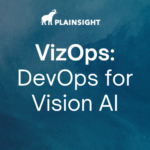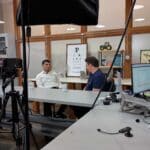Vision AI is transforming how industries, from livestock management to manufacturing, solve complex problems. Yet, deploying vision AI models effectively and efficiently remains a major challenge. However, according to Insight Editor, nearly 90% of AI vision projects fail, despite the very high demand for computer vision within companies. Based on our conversations with hundreds of practitioners, developers, and customers, we see major challenges stemming from disjointed, manual workflows that delay results and waste time for developers and machine learning (ML) engineers. Instead of using their time to build intelligent applications, teams get bogged down in ingesting, organizing, and annotating massive, messy video streams and inconsistent metadata. The result? Hours lost to wrangling data—time that should be spent delivering real CV impact.
The Simple Vision Pipeline That Everybody Wants

Your vision application architecture begins with a simple spark: you have existing cameras, video footage, or images, and you want to build an application that understands what it sees. By layering on AI, you can generate accurate subject data and feed it downstream to drive real-time insights—turning pixels into profit. This simple architecture can support unlimited use cases in business from tracking inventory, counting cars, ensuring food order accuracy, watching & recognizing people, ensuring compliance, and more.
Introducing VizOps: A New Way to Build with Vision
Building and deploying computer vision applications is fundamentally different from traditional software or ML systems. Vision introduces a unique set of challenges: massive, messy video streams, inconsistent metadata, and brittle, manual workflows that slows teams down. What’s needed isn’t just a set of tools, but a new way of working.
VizOps is the emerging practice that brings DevOps principles, automation, repeatability, and collaboration to the entire vision AI lifecycle. It’s a shift from ad hoc scripts and handoffs to a streamlined, developer-first approach to building vision-powered applications.

Here’s how a modern VizOps workflow looks in practice:
Code
Every vision application begins with logic and rules that determine what to look for and how to process what’s seen. Writing a filter in a familiar codebase makes it easy to define that logic using standard tools and programming languages, so developers can iterate quickly without reinventing the wheel. Models and code must come together to create a vision application or solution that meets a business goal over time.
Capture
Your cameras are already generating vast amounts of video and image data. This footage can be used both for live inference and for model training. The first step is collecting and organizing that data, often across multiple formats and devices, into a structure your system can work with. VizOps seeks to automate as much of this process as possible to feed video and image data directly into processing pipelines with minimal human interaction.
Curate
Manually wrangling video data is time-consuming. Automation can help by deduplicating frames, detecting objects and embeddings, and using pretrained models to pre-annotate images. This turns raw data into a usable training set faster, with less human effort. VizOps enables reuse of vision applications across the lifecycle to improve automation and reuse of investments to reduce manual work.
Train
Once your data is annotated, it’s time to train or fine-tune your models. Whether starting from scratch or adapting an existing model, this stage helps build the intelligence that powers your vision workflows—accurate, repeatable, and tailored to your use case. VizOps also means benchmarking and testing models in an automated fashion to speed updates and avoid moving backwards in terms of accuracy and performance
Deploy
With a trained model in hand, the next challenge is running it in production. That means scheduling vision workloads, updating models safely, and ensuring that they run reliably across devices. Monitoring, versioning, and rollback support are essential to keeping your system resilient and up to date. Deployments are required for testing, development, and other tasks as well as edge inference, so VizOps means deploying wherever you need your vision app in the full lifecycle.
Serve
Ultimately, the goal is to use vision AI in the real world—to detect, classify, and interpret what’s happening in your environment. Serving models turns live video into structured data or annotated visuals that can feed downstream apps, dashboards, or automated actions. VizOps will enable you to continually improve your inference by serving the best models and code available based on testing and real world performance, and feed real world data back into the beginning of the process.
Enter OpenFilter
As part of our continued push to accelerate vision development, we created OpenFilter, a universal abstraction that unpacks code and machine-learning logic into composable vision applications. Originally built for high-scale enterprise workloads, it is now open to the entire vision community. Any developer can use it to quickly turn ideas into working, composable vision applications.
Getting started is easy: download and explore OpenFilter to see it in action and if you’re working on an enterprise computer vision use case and want to collaborate, we’d love to hear from you.




